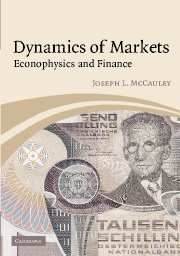Book contents
- Frontmatter
- Contents
- Preface
- 1 The moving target
- 2 Neo-classical economic theory
- 3 Probability and stochastic processes
- 4 Scaling the ivory tower of finance
- 5 Standard betting procedures in portfolio selection theory
- 6 Dynamics of financial markets, volatility, and option pricing
- 7 Thermodynamic analogies vs instability of markets
- 8 Scaling, correlations, and cascades in finance and turbulence
- 9 What is complexity?
- References
- Index
5 - Standard betting procedures in portfolio selection theory
Published online by Cambridge University Press: 31 October 2009
- Frontmatter
- Contents
- Preface
- 1 The moving target
- 2 Neo-classical economic theory
- 3 Probability and stochastic processes
- 4 Scaling the ivory tower of finance
- 5 Standard betting procedures in portfolio selection theory
- 6 Dynamics of financial markets, volatility, and option pricing
- 7 Thermodynamic analogies vs instability of markets
- 8 Scaling, correlations, and cascades in finance and turbulence
- 9 What is complexity?
- References
- Index
Summary
Introduction
Of course, everyone would like to know how to pick winning stocks but there is no such mathematical theory, nor is a guaranteed qualitative method of success available to us. Given one risky asset, how much should one then bet on it? According to the Gambler's Ruin we should bet the whole amount if winning is essential for survival. If, however, one has a time horizon beyond the immediate present then maybe the amount gambled should be less than the amount required for survival in the long run. Given two or more risky assets, we can ask Harry Markowitz's question, which is more precise: can we choose the fractions invested in each in such a way as to minimize the risk, which is defined by the standard deviation of the expected return? This is the beginning of the analysis of the question of risk vs reward via diversification.
The reader is forewarned that this chapter is written on the assumption that the future will be statistically like the past, that the historic statistical price distributions of financial markets are adequate to predict future expectations like option prices. This assumption will break down during a liquidity crunch, and also after the occurrence of surprises that change market psychology permanently.
Risk and return
A so-called risk-free asset is one with a fixed interest rate, like a CD, money market account or a treasury bill. Barring financial disaster, you are certain to get your money back, plus interest. A risky asset is one that fluctuates in price, one where retrieving the capital cannot be guaranteed, especially over the long run.
- Type
- Chapter
- Information
- Dynamics of MarketsEconophysics and Finance, pp. 91 - 120Publisher: Cambridge University PressPrint publication year: 2004



